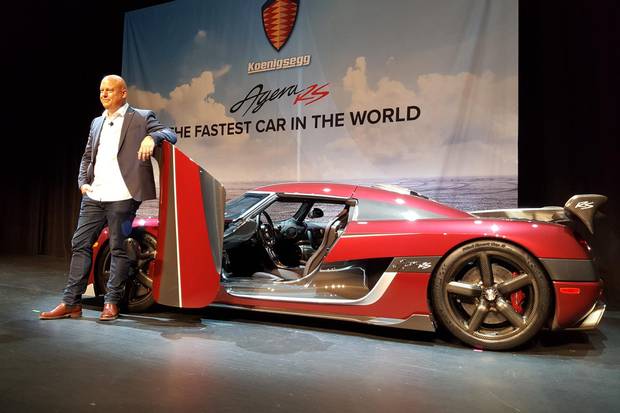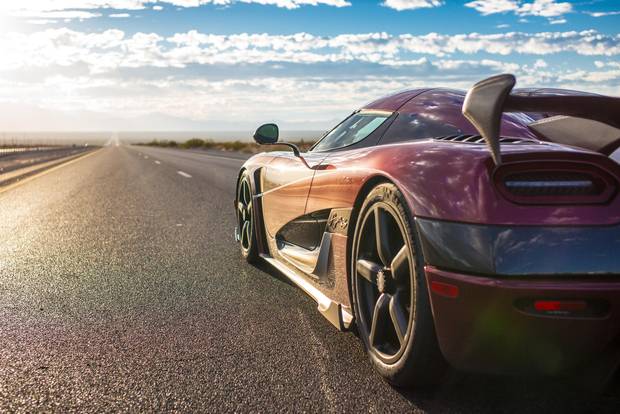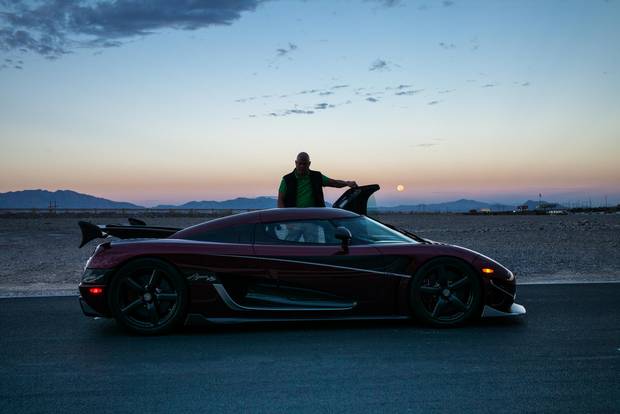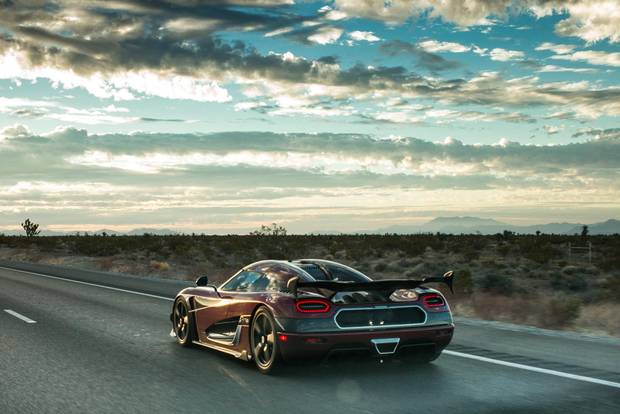Christian von Koenigsegg founded his own car company in Sweden in 1994 when he was just 22 years old. Since then, his exotic hypercars have set records for being the fastest and among the most expensive production cars in the world.
Last November, a Koenigsegg Agera RS set the record for the fastest speed on a public road, closed especially for the run: It reached an average of 447 kilometres an hour during two passes, one in each direction, on Nevada's Route 160, near Pahrump.
At the same time, it set the record for fastest time to accelerate from zero to 400 km/h, and then brake back down to zero: 33.29 seconds. This beat the record set by a Bugatti Chiron in September by nearly six seconds.
In making the Nevada run, the company also beat the record for highest average top speed in a Flying Mile on a public road – a record that had stood since 1938, when a Mercedes W125 race car drove on the autobahn at almost 445 km/h.
Von Koenigsegg was in Toronto last week to bring the same Agera RS to the Canadian International AutoShow, where we caught up with him to ask about record-setting, crash-testing and Canada.
First of all, how much does this car cost?
Von Koenigsegg: In Canada, depending on how the cars are specced, without taxation, they start at about US$1.8-million, but then if you have clear carbon, and this, and this, and this, they kind of go up to about US$2.5-million. That's U.S. dollars, so about $3-million Canadian. But since there are only 25 made and they're all sold out, it seems the value is quite different to that and they're now worth a lot more.
Why is it important to set a record?
Well, there's a sense of achievement for everyone working at Koenigsegg that you're doing something special. There's showcasing what is under the skin of the car – to make a beautiful car is one thing, but to make it perform on every level and to make it comply on every level at the same time, is really difficult. It shows the level of technology and the level of commitment, and it's interesting to do that at a higher level than everyone else.

Christian von Koenigsegg with one of his company’s cars at the Canadian International AutoShow.
tom maloney/the globe and mail
But an owner is not going to do this – drive at such speed?
In this case, it was actually an owner's car, Mark Stidham. He told us last year that when he gets the car, he wants to shut down a road and see how fast it is. And we said, we've been trying to shut down a road for years and never managed to do it – it's not so easy. And then he called us back and said he'd actually managed to shut down a road. So we said "okay, but probably we should help out, because it can be dangerous." As we've never driven that fast, we needed to calibrate the aerodynamics at that speed, software-wise, so we put in sensors on the shock absorbers, so we could see the rake of the car and how it changed at speed. We put in the software to balance it out and now all RSs have that software, because now we have the reference.
What is it about this car that makes it the fastest car? What does it have that the Bugatti doesn't have?
We have a much smaller engine, with half the size and half the cylinders and half the turbos. But the engine is superpowerful for what it is. The big difference is we're much lighter. And then there's aerodynamics. We apparently have much less drag.
Do you have your own wind tunnel for testing?
We have our own supercomputer, with a CFD program, where we run iterations every day, and we have our own runway, because we're situated at an airport. It's completely flat, and on days with no wind we can do what we call coast-down tests: We speed up to a speed, and then we let it roll in neutral and then we can see how quickly it slows down, and then you can correlate your drag numbers from that through the computer to see that it makes sense.
And we have potentiometers in the shock absorbers in the car, so in coast-down we can see the down force, or lack of it, and then we correlate to the computer. And when we see correlation, we keep on going with the computer.
That's better than a wind tunnel, because it's actually what they call IRL – "in real life" – because it's on the road. We've used the wind tunnel at Gothenburg, but we don't see any need now, with the runway and the simulator.
How many Agera RSs are there right now?
There are two prototypes and 25 customer cars in existence, but the two or three last ones are in PDI in Sweden. They're not with their customers yet, but two of them are for Canada.

There are two prototype Agera RSs and 25 customer cars in existence.
Koenigsegg
Why are you here in Canada?
There's a huge market for sports cars in Canada, and a long tradition of sports cars and racing. We're a small company, so we've kind of step-by-step reached out around the world and now we've made it as far as Canada, due to the fact we've found a really good partner to work with here, the Weissach Group. We don't really think so much in "countries" – it's more finding the right customers and people to work with, and that led us to Canada.
What part of the world likes your cars the most?
Right now it's the U.S. It used to be China, and Japan is up there as well. Europe is stable.
How many cars did you sell last year?
We delivered 18 cars. We sold 60, and then we were sold out, so we're trying to ramp up a little bit. We are now 170 people and we have about 60 vacancies, where we would like to find more people to train. It's very much a skill-driven production of artisans – it's not a robot production line.
What is the status of your cars in the United States, with crash-testing?
They're fully homologated. We have smart airbags. We comply with EPA and CARB. It's like any other regular car, but it was a daunting, tough process to get there that took a little bit longer than we had hoped. But finally we managed to go through all the hoopla.

Koenigsegg delivered 18 of its cars last year.
Steven Wade/Koenigsegg
What's the challenge to it?
The rules and regulations are designed for large car companies. For them, spending a couple of hundred million dollars is only a small part of their development budget. For us, we have to do the same kind of job for the same kind of result, but we can't spend that money, so it's really difficult.
In total, it's over 20 different crash tests, and if you're General Motors, you take some unpainted car off the line and smash it in the front corner and then you throw it away, and then you take another one and smash it in the rear and then you throw it away, because it's cheaper. In our case, we have to rebuild the car every time, because we want to save the expensive monocoque in the centre. So we have to rebuild it, crash it, rebuild it, crash it, to make it viable from a cost perspective.
The other thing is that we have to be very, very sure before we start any crash testing that we don't fail, because it's too expensive. We passed every crash test the first time, and I heard afterwards that no one had ever done this before. We just really put in an effort not to fail and over-engineer the thing.
Do you want to stay a small company?
We want to grow in a controlled way. We don't have an ambition to become huge, but we don't want to shrink, either. We want steady growth. If we look at Lamborghini in the seventies, they were pretty much what we are now, but now they're something different.
Will there ever be a Koenigsegg SUV?
Probably not. Probably not.
What is your daily driver?
A Tesla Model S. The low-end torque, the directness of power and the efficiency is fascinating, and that kind of led me to develop the (electric-assisted) Regera. It's a combustion-engine car [with] direct electrification and efficiency, but with the roar and much more power. That's the perfect combination.
My wife has a few cars: A Range Rover, a Mazda MX-5. We had one when we met years ago, and it's a nostalgic thing. I drive it and I like it.
Shopping for a new car? Check out the new Globe Drive Build and Price Tool to see the latest discounts, rebates and rates on new cars, trucks and SUVs. Click here to get your price.
